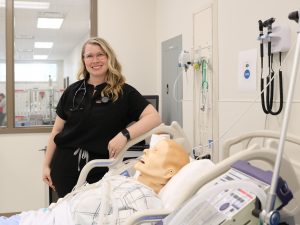Murray Knuttila remained reflective this fall when the new National Survey of Student Engagement (NSSE) showed that senior Brock students rate their university more favorably than the Ontario and Canadian averages for students at other universities.
Likewise, when the Maclean’s University Rankings this week placed Brock at the bottom of its Overall Ranking list for comprehensive universities, Knuttila says it was not a surprise.
This year, Maclean’s moved Brock, Ryerson and Wilfrid Laurier universities from the primarily undergraduate to the comprehensive category. Comprehensive universities are defined as having significant research activity and a wide range of undergraduate and graduate programs. Brock recently passed 18,000 in total enrolment, and has more than 40 masters and doctoral programs.
“You have to be realistic in expectations,” said Knuttila. “It’s our first year being compared in this senior category.
“We’re proud to be positioned alongside leading comprehensive universities, but the calculation for Overall Ranking is influenced by total amounts of research funding, and other universities have longer histories as research-intensive institutions. They have more professional programs, some have engineering schools. These activities make it easier to attract major research funding from both government and private sources.”
Brock is a school in transition, says Knuttila. In the past decade, it created a Vice-President of Research and became one of Canada’s top universities in growth rate for research funding. Its expanding graduate programs attract more and better students, research activity is growing constantly, and next spring Brock will open the $111-million Cairns Family Health and Bioscience Research Complex.
Knuttila says some of the bright spots in the Maclean’s report reinforce Brock’s reputation for excellence in teaching and for being student-focused.
“We rank sixth among all comprehensive universities when measuring scholarships and bursaries as a percentage of the university budget. We’re third in terms of student services as a percentage of budget. And Maclean’s pointed out that more than 93 per cent of our faculty have terminal degrees.
“We’re proud of our high-quality faculty, and proud that Brock is highly regarded in terms of scholarship and support.“
Knuttila said these strengths show up in Brock’s high student retention rates, though input surveys like the Maclean’s rankings do not capture or reflect the student learning experience offered by Brock’s seminar and small group tradition.
University President Jack Lightstone said this year’s Overall Ranking result is the inevitable price of growing into a new category.
“A little more than a decade ago, we decided to pursue the goal of becoming a comprehensive university,” said Lightstone, “a university with extensive research activity and a broad array of graduate programs, in addition to undergraduate programs. Now Maclean’s has decided we have finally graduated into that class of institutions — one of the new kids in the class.
“Over the coming years we will continue along our developmental path among our new peer-group of universities.”
Meantime, a respected quality indicator for North American universities suggests that Brock students place increasing levels of value on their university the longer they study here.
The latest National Survey of Student Engagement (NSSE) showed Brock senior students consistently scored Brock higher than both the Ontario and Canadian averages on benchmarks of level of academic challenge; active and collaborative learning; student-faculty intervention; and supportive campus environment. They also topped provincial and national averages when asked “How would you evaluate your entire education experience at this institution?” and “If you could start over again, would you go to the same institution?”
NSSE scores are based on surveys with thousands of students at universities in Canada and the United States.
Knuttila admits he would like to see the same higher levels of engagement among entry-level students, “but the fact that student engagement scores improve dramatically by the time they become seniors means we are doing something right.”









